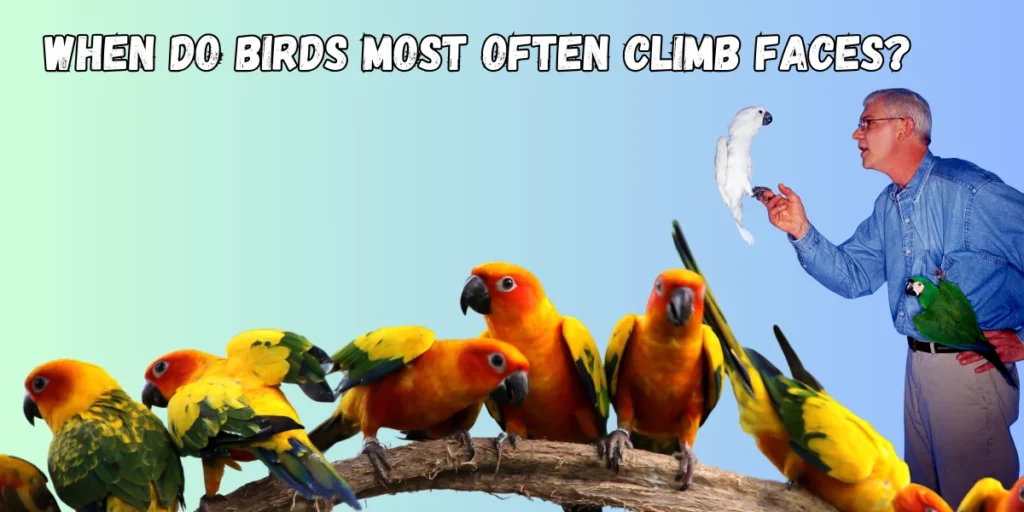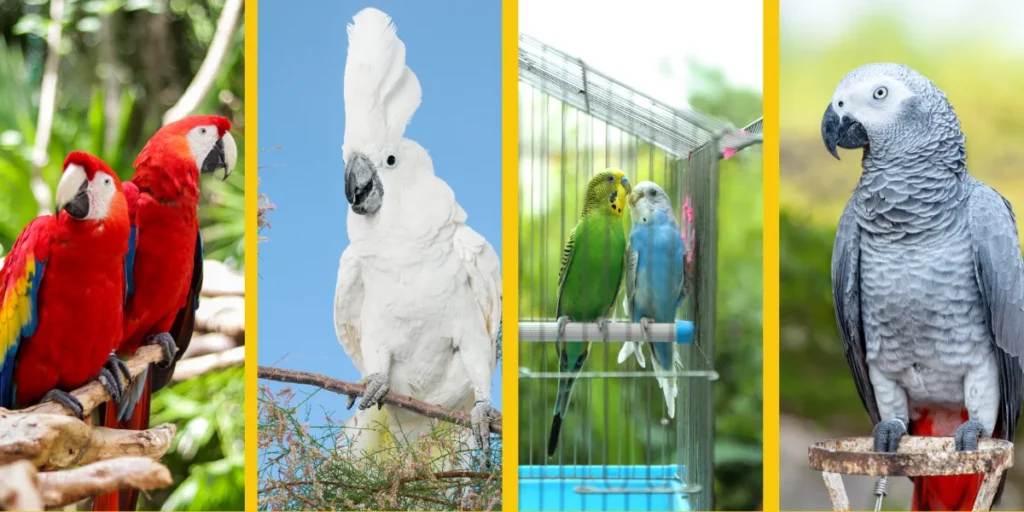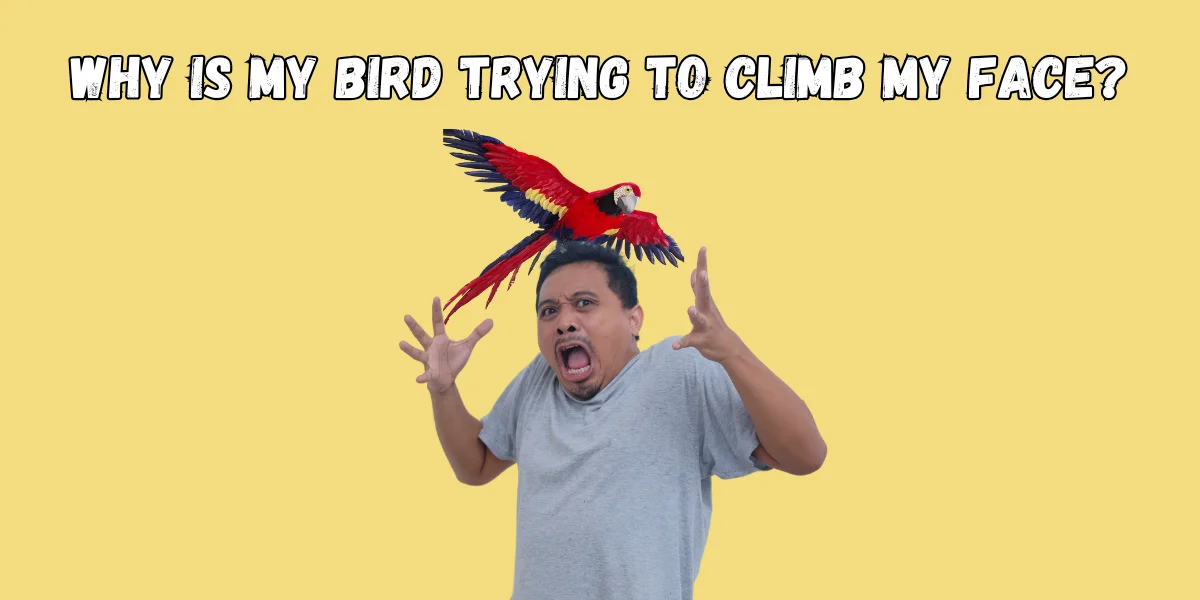If you’ve found yourself asking, “Why is my bird trying to climb my face?”, you’re not alone! Birds climbing on their owners’ faces is a common behavior and can be confusing at first. Often, this face-climbing behavior is a way for birds to show affection, get your attention, or explore their environment up close.
Let’s dive into the reasons behind this behavior and explore simple ways to manage it so you and your bird can have a happy, enjoyable time together.
Why Is My Bird Climbing on My Face? Key Reasons and Solutions
Mate Bonding Behavior
- Your bird may see you as a mate, leading to clingy behaviors like face climbing.
- Solution: Keep petting to head and neck areas only. Avoid cuddling, hugging, or sleeping with your bird to prevent over-bonding.
Attention-Seeking and Curiosity
- Birds crave interaction and explore by getting close. Face climbing is often a way to be near you or get your attention.
- Solution: Provide daily playtime, interactive toys, and other bonding activities to fulfill their social needs.
Hormonal Triggers
- Certain types of petting (like touching below the neck) can activate your bird’s hormones, leading to behaviors like face climbing.
- Solution: Stick to gentle head and neck scratches to avoid stimulating hormonal reactions.
Flight-Related Behaviors
- Fully flighted birds may attempt to land on or climb you more frequently as a way of staying close.
- Solution: Consider light wing trimming to control face landings without fully restricting their ability to fly.
Stress and Comfort Seeking
- Environmental changes can cause stress, making your bird seek comfort from you by climbing on your face.
- Solution: Keep their environment calm and consistent, and offer comfort through gentle presence rather than face climbing.

What Does It Mean When My Bird Climbs My Face?
Birds are naturally social animals that love spending time with their owners. Climbing on your face can mean several different things:
| Reason | Description |
|---|---|
| Affection and Bonding | Birds see you as part of their “flock” and want to be close. Climbing your face is like a bird hug! |
| Attention-Seeking | Birds love attention. If they feel ignored, climbing on your face is a quick way to make sure you notice them. |
| Curiosity | Birds are curious and want to explore everything—including your face. They might want to look at you up close or check out what you’re doing. |
| Excitement | When birds are happy, they want to be close to you and might climb your face as part of their excitement during playtime. |
| Comfort Seeking | If your bird is scared or stressed, climbing on your face can be a way for them to feel safe and close to you. |
Now, let’s look more closely at each reason.
1. Affection and Bonding: Showing They Care
Birds are social and affectionate animals. In the wild, they live in flocks, often very close to one another. For pet birds, you are their flock! Climbing your face is their way of saying they feel safe with you and want to be close. This behavior shows they trust you and want to bond with you in a physical way.
Example:
- Parrots: Parrots are particularly known for their close bonds with their owners. If your parrot climbs your face, it’s likely showing affection and wants to be as close to you as possible.
How to Encourage Healthy Bonding:
- Provide Alternatives: If your bird wants to be close to you, try guiding it to sit on your shoulder instead.
- Show Affection in Return: Gently talk to your bird or offer them a head scratch to let them know you care.
2. Attention-Seeking: “Look at Me!”
Birds are very social creatures that crave attention, especially from their favorite humans. If your bird feels ignored, it might climb your face to get your focus. Climbing on your face is one of the fastest ways to make sure you’re paying attention to them.
Example:
- Cockatoos: These birds are famous for their need for attention and can become quite attached to their owners. Face climbing is a quick way for them to make sure they’re getting noticed.
Solution:
- Give Daily Attention: Try to spend 30 minutes to an hour each day interacting with your bird. If they know they’ll get regular attention, they may feel less need to climb on your face.
3. Curiosity: Exploring Up Close
Birds are naturally curious. They explore their surroundings with their beaks, claws, and feet, and sometimes, your face is part of their exploration! Climbing your face may be their way of trying to get a closer look at you, especially if you’re doing something interesting, like talking or making facial expressions.
Example:
- Lovebirds: These small birds are incredibly curious and may want to inspect everything, including your face, up close.
Solution:
- Offer Interesting Toys: Provide toys that stimulate their curiosity, like puzzle toys or treat-dispensing toys. These can keep your bird’s mind active and help reduce face climbing.
4. Excitement: Playtime Fun
Sometimes, birds climb your face simply because they’re excited and want to play. During active moments, they may climb up as a way to interact with you or join in the fun. Birds feel your energy, and when they sense you’re engaged, they get excited too.
Example:
- Parakeets (Budgies): These small, playful birds can get very excited and sometimes climb up to your face when they’re feeling happy and engaged.
Solution:
- Interactive Playtime: Use toys like feathers, ropes, or small balls to engage with your bird without encouraging face climbing. When they focus on toys, they’re less likely to try to climb your face.
5. Comfort Seeking: Feeling Safe
Changes in your bird’s environment—such as a move, new pet, or changes in your routine—can make them feel insecure. Birds seek comfort by getting closer to someone they trust. Climbing on your face can be their way of seeking safety, especially during stressful times.
Example:
- African Grey Parrots: Known for their intelligence and sensitivity, these birds may climb on you more frequently if they feel anxious.
Solution:
- Create a Calm Environment: Try to keep your bird’s space calm and stable. Avoid sudden loud noises, and keep their routine as consistent as possible. A relaxed environment helps birds feel secure.

When Do Birds Most Often Climb Faces?
Birds are more likely to climb your face during certain activities or situations. Here’s a table to help you understand when this behavior may happen most:
| Situation | Why They Might Climb Your Face |
|---|---|
| Interactive Playtime | Birds get excited during play and want to be close to you. |
| Social Activities | If you’re talking to others or on the phone, birds want in! |
| Environmental Changes | Moving homes or getting a new pet can make them feel anxious. |
| Routine Changes | If you’re busier than usual, they may seek more attention. |
By understanding these situations, you can anticipate when your bird might try to climb on your face.
Simple Solutions to Manage Face Climbing
If face climbing is becoming too frequent or if you’d prefer your bird not to climb on your face, there are several methods you can use to redirect their attention and create new habits.
1. Training Alternative Behaviors
Teaching your bird to do other things besides climbing on your face can be a fun bonding activity. Here’s how:
- Use Treats as Rewards: When your bird engages in a different activity (like sitting on your shoulder or playing with a toy), reward it with a treat.
- Practice Commands: Use simple commands like “step up” to help guide your bird to other areas. Repeating this can help them learn to sit in places other than your face.
2. Providing Engaging Toys
Birds need mental and physical stimulation. Toys that encourage chewing, problem-solving, and exploration help keep them busy and satisfied. Try providing:
- Puzzle Toys: Toys with hidden treats or puzzles to solve.
- Foraging Toys: Toys that require your bird to work for treats.
- Chewable Toys: Wooden or shreddable toys that are safe for them to chew on.
Preventing Stress in Birds: Tips for a Calm Environment
A calm and predictable environment helps reduce stress in birds, which can reduce the need for face climbing. Here are some ways to create a peaceful space for your bird:
- Keep Their Area Quiet: Avoid sudden loud noises near your bird’s cage, as loud sounds can be frightening.
- Establish a Routine: Birds are creatures of habit, and a regular schedule can make them feel safe. Try to feed, interact, and put them to sleep at the same time each day.
- Provide a Secure Cage: Ensure their cage has a comfortable setup with perches, toys, and enough room to move around. A secure, cozy cage can help them feel more at ease.
FAQs
Here are answers to some of the most common questions about face climbing in birds:
1. Is it normal for my bird to climb my face?
Yes, it’s very normal! Many birds do this as a way of bonding or exploring. But if it becomes too frequent, you can redirect their attention.
2. How can I stop my bird from climbing my face?
Offer alternative activities, like toys or interactive play, and use treats to reward them for not climbing your face.
3. What kind of toys are best for my bird?
The best toys encourage your bird to be active and use their mind. Try puzzle toys, chewable toys, and toys that allow them to forage for treats.
4. How can I tell if my bird is bored?
Signs of boredom in birds include excessive squawking, destructive behavior, or trying to escape the cage. If you notice these signs, provide new toys and extra interaction.
5. Can stress make my bird climb my face more often?
Yes, stressful situations can lead birds to seek comfort by getting close to you, which includes face climbing. Providing a calm environment helps.
6. What should I do if my bird is aggressive while climbing my face?
If your bird becomes aggressive, gently guide it to a perch or toy and
avoid reacting negatively. Consistently encouraging better behaviors will help them learn.
Which Bird Species Are Most Likely to Climb on Faces?
While all birds can be curious and affectionate, some species are more likely to climb on faces due to their strong need for interaction:
| Species | Face Climbing Behavior |
|---|---|
| Parrots | Known for affection, they often show love by climbing on you. |
| Cockatoos | These social birds crave attention and may climb faces frequently. |
| Budgies (Parakeets) | Very curious and playful, they enjoy exploring up close. |
| African Grey Parrots | Sensitive and intelligent, they may climb faces when feeling anxious. |

Conclusion: Embrace Your Bird’s Personality While Setting Boundaries
Face climbing is a natural behavior for birds that reflects their need for social interaction, curiosity, and affection. By understanding why they do it, you can manage this behavior in a way that keeps both you and your bird happy. Encourage alternative behaviors, provide plenty of toys, and maintain a calm, consistent environment to reduce the frequency of face climbing.
Remember, each bird has its unique personality and needs. Embracing this while gently guiding them toward other positive interactions will help create a long-lasting bond with your feathered friend.
